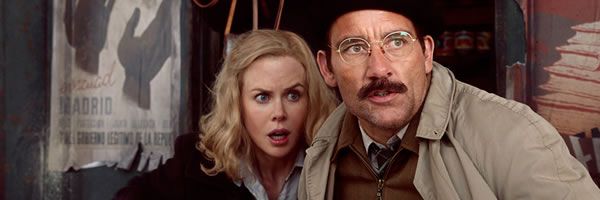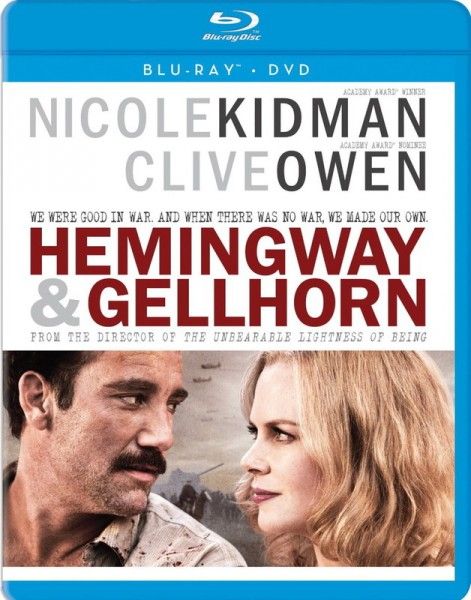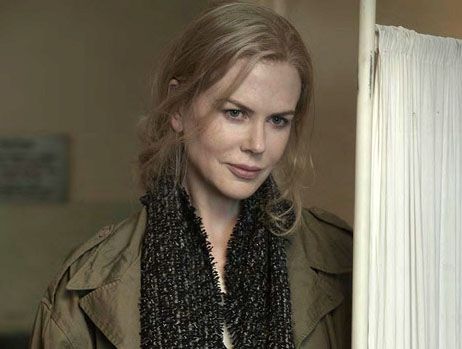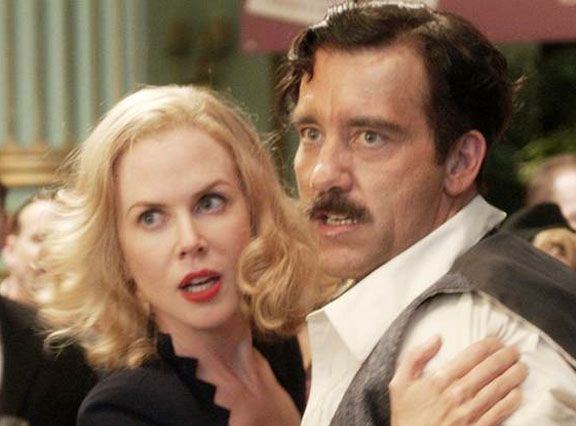HBO has become one of the great places for auteurs to make cheaper movies. Of late we’ve seen Todd Haynes and Steven Soderbergh turn to the channel to get films made, and now Philip Kaufman has joined their ranks. The man behind The Right Stuff and The Unbearable Lightness of Being directed Hemingway & Gellhorn, a biopic about Ernest Hemingway’s one-time wife and reporter Martha Gellhorn. And for the film he got Nicole Kidman and Clive Owen to star as his drunken lovers. Our review of the Blu-ray of Hemingway & Gellhorn follows after the jump.
Told partly through the perspective of an older Gellhorn (Kidman), it shows their introduction at Sloppy Joe’s bar in Key West. She’s a writer who’s been compared to Hemingway, he’s a drunken lout who just caught a big game fish. There is an attraction, but he’s married to Pauline (Molly Parker). Ernest’s friends, including John Dos Passos (David Strathairn) are covering the Spanish civil war, and Martha wants to go to write about it. And by her going, Hemingway also decides to cover the war so the two can get to know each other. There, along with a film crew headed up by documentarian Joris Ivens (Metallica’s Lars Ulrich), they see the rebel fighters and the Russian presence. And during one bombing, the two finally consummate their attraction.
Pauline is Catholic, so she doesn’t believe in divorce, but once they return to America to release their documentary, their love affair is a barely kept secret. Both are incredible writers and drinkers. Eventually Pauline relents and the two get married, but without a war in their lives they grow restless and fight. When World War II breaks out, Martha wants to cover it, but her assignment is stolen out from under her by Ernest himself.
As a TV movie one lowers one’s standards a little, but it’s hard to get too excited about Hemingway & Gellhorn. Martha Gellhorn is a fascinating figure, and the movie gets some of that on screen, but there’s not much to the characterization. She isn’t well known enough to make it seem like mimicry, and the events are interesting, but she’s someone who fell in love with a famous person and who was overshadowed by the relationship. So is the movie, though it gives Kidman the spotlight. And though Clive Owen can be a wonderful actor, his Hemmingway goes through the motions one expects of the larger than life character while Owen never sinks into the role. He plays the smirking bastard part well, but neither performer captures the inner life of these geniuses. As Hemmingway ages, Owen looks more like Groucho Marx with his mustache and cigar than Hemingway and he only comes across as the man once he’s playing the elderly version.
Kidman does okay work for the most part as a woman who knows how to play with the boys and use her looks to get much of what she wants, but perhaps it’s the pacing. At over two and a half hours, the film plods along. Philip Kaufman is in his 70’s, and this has the pacing of an old man movie. He’s still good with actor, but the film has a weak pulse. And he also means that performers like Robert Duvall and Brooke Adams show up for no reason, other than it’s kind of awesome that they do.
But Kaufman makes a stylistic choice that sinks the movie. In The Unbearable Lightness of Being, to show the Czech revolution, he cut his actors into black and white documentary footage. Here Kaufman does that not just for a section of the film, but all the time as the film slips from color to black and white so often it becomes distracting, and partly because it’s evident that computer graphics are being employed. During the Spanish Civil War section of the movie it happens so frequently that it becomes obnoxious. It was likely the only way to keep the film under budget, but it doesn’t work as a visual trick because you are constantly made aware of the film’s artifice, but not for purpose.
With an all star cast that also includes Parker Posey and Tony Shalhoub, there are enough things to like to make it not a complete waste. But where Todd Haynes was able to do something fascinating while still making something for cable, Kaufman’s film feels like an R-rated TV movie of the week.
HBO’s Blu-ray presents the film in widescreen (1.85:1) and in DTS-HD 5.1 Master audio. The transfer is nice, and the film looks as good as it must have when broadcast. The film comes with a commentary by Kaufman and editor Walter Murch and they pop in and out of the movie, and mostly talk about how much of the film was shot in San Francisco. There are also two featurettes ‘Behind the Visual Effects’ (5 min.) and ‘Making Hemingway & Gellhorn’ (6 min.), both offer cursory overviews of their subjects.




